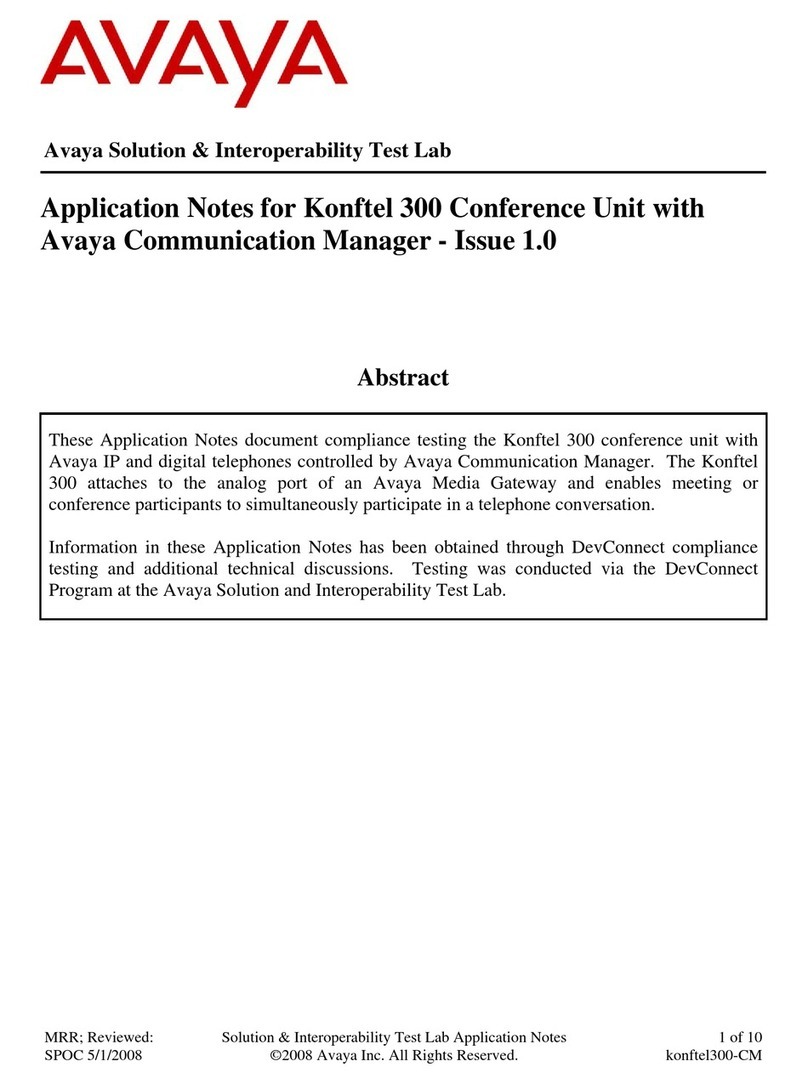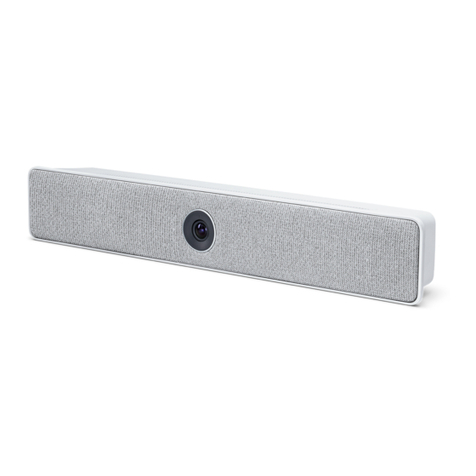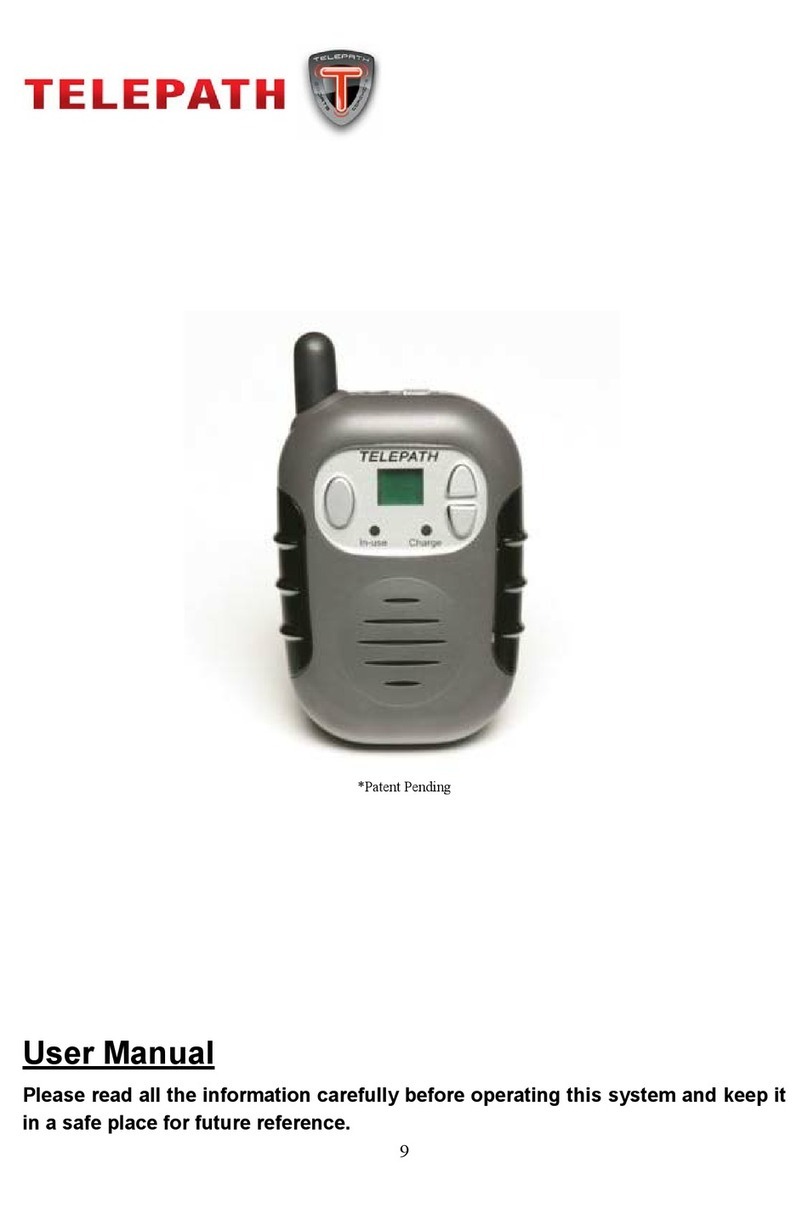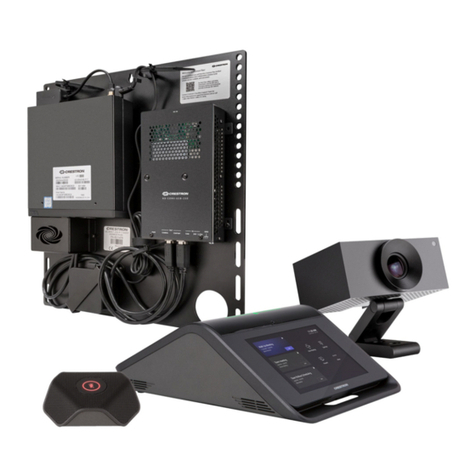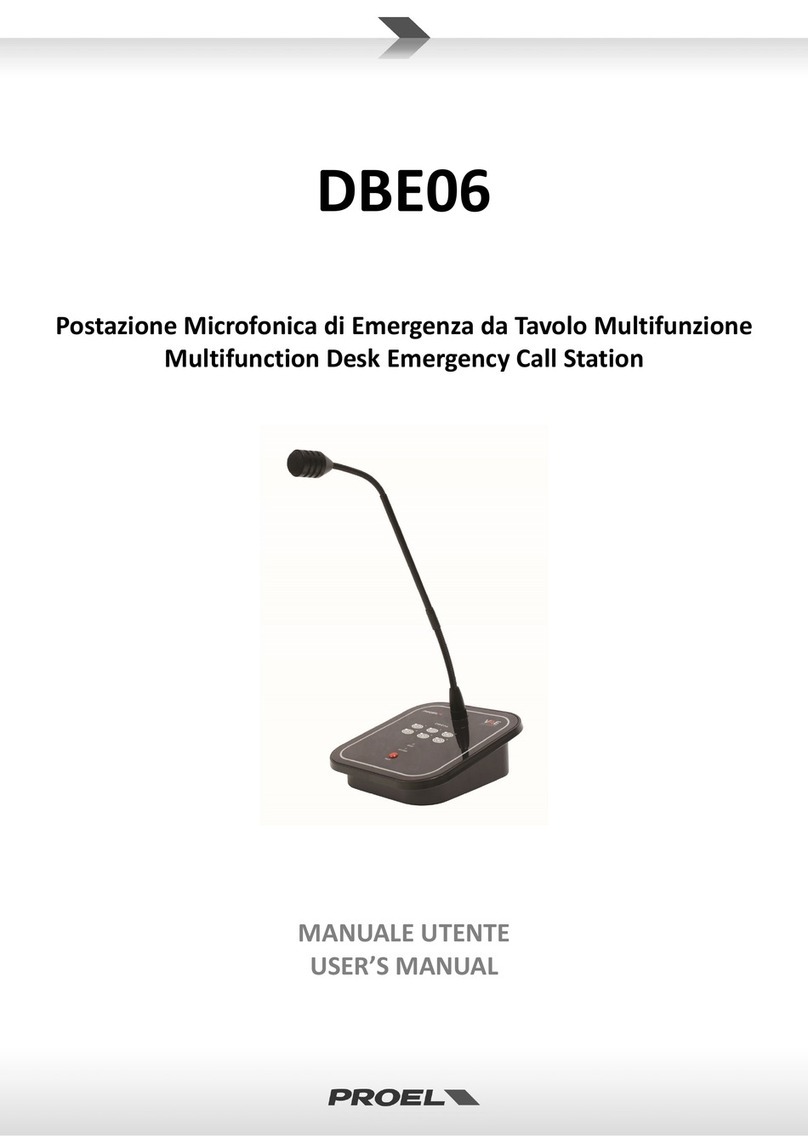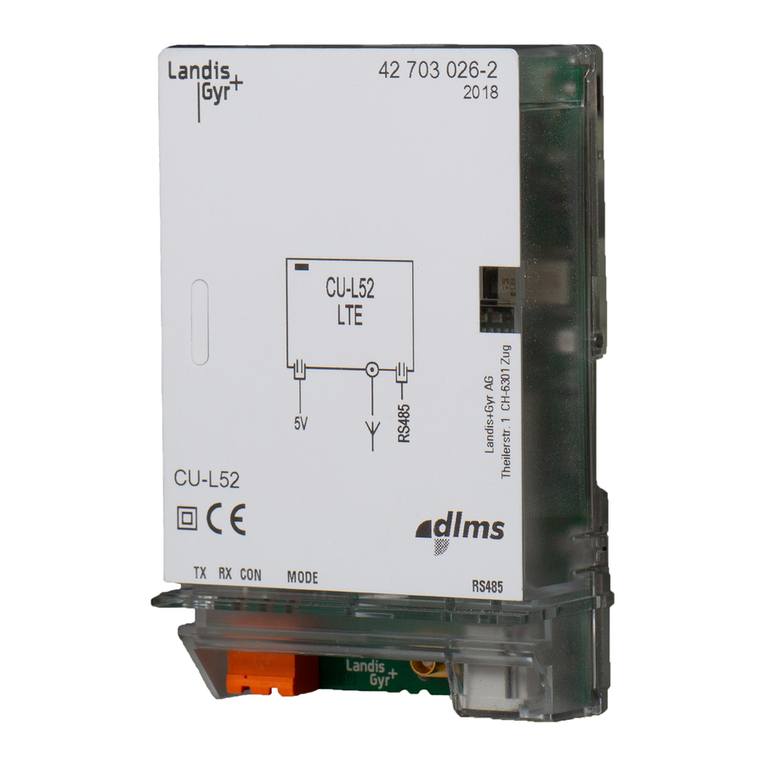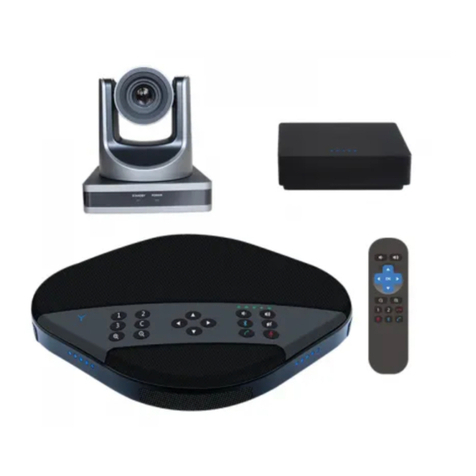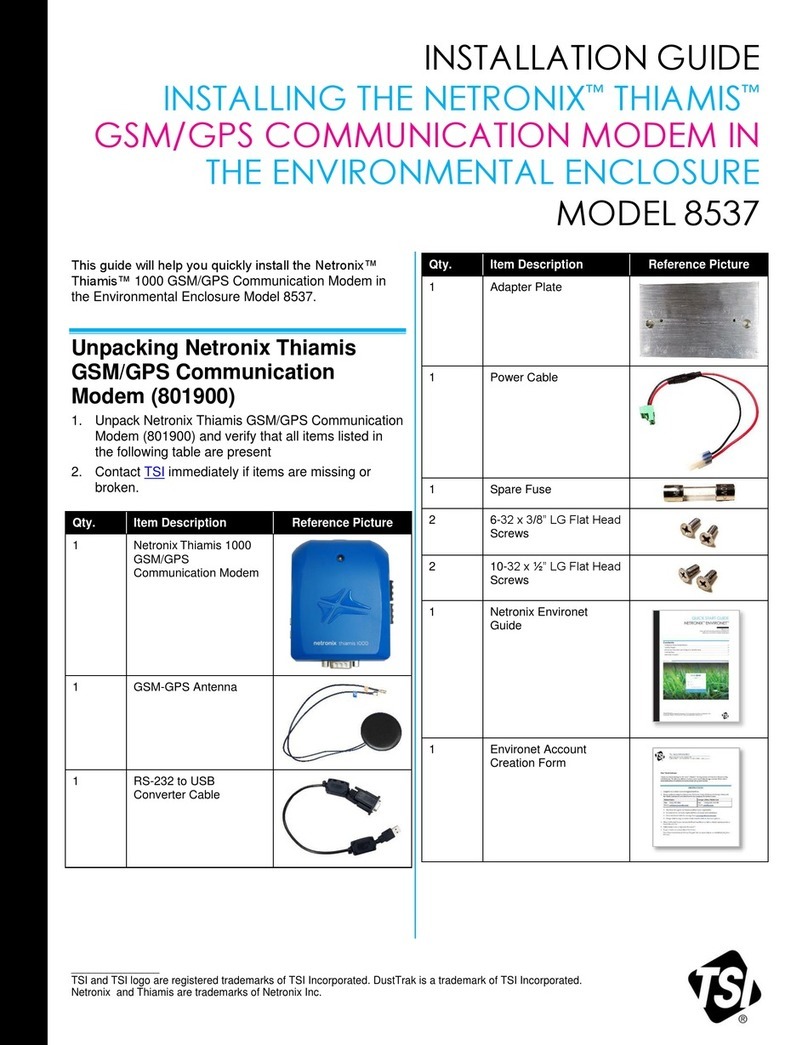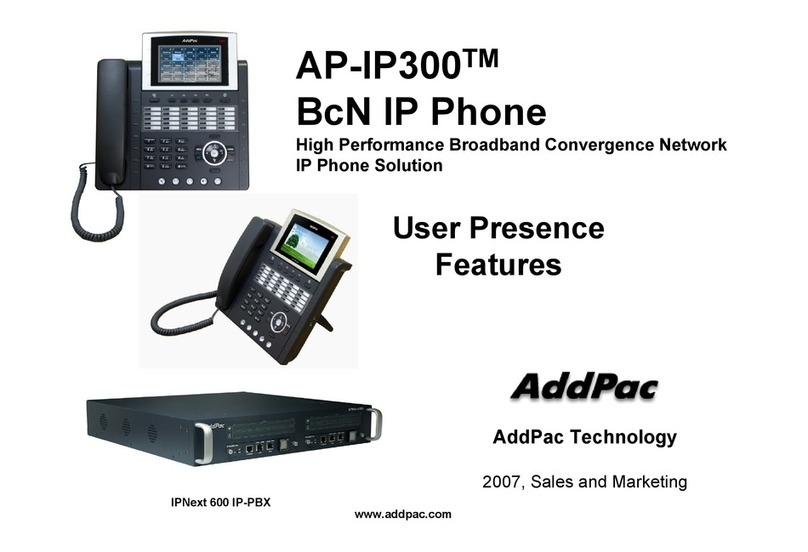Cirrus Logic CS4265 User manual

Copyright Cirrus Logic, Inc. 2012
(All Rights Reserved)
http://www.cirrus.com
104 dB, 24-Bit, 192 kHz Stereo Audio CODEC
D/A Features
Multi-Bit Delta Sigma Modulator
104 dB Dynamic Range
-90 dB THD+N
Up to 192 kHz Sampling Rates
Single-Ended Analog Architecture
Volume Control with Soft Ramp
– 0.5 dB Step Size
– Zero Crossing, Click-Free Transitions
Popguard® Technology
– Minimizes the Effects of Output Transients
Filtered Line-Level Outputs
Selectable Serial Audio Interface Formats
– Left-Justified up to 24-bit
– I²S up to 24-bit
– Right-Justified 16-, 18-, 20-, and 24-bit
Selectable 50/15 µs De-Emphasis
A/D Features
Multi-Bit Delta Sigma Modulator
104 dB Dynamic Range
-95 dB THD+N
Stereo 2:1 Input Multiplexer
Programmable Gain Amplifier (PGA)
– ± 12 dB Gain, 0.5 dB Step Size
– Zero Crossing, Click-Free Transitions
Pseudo-Differential Stereo Line Inputs
Stereo Microphone Inputs
– +32 dB Gain Stage
– Low-Noise Bias Supply
Up to 192 kHz Sampling Rates
Selectable Serial Audio Interface Formats
– Left-Justified up to 24-bit
– I²S up to 24-bit
High-Pass Filter or DC Offset Calibration
1.8 V to 5 V
Multibit
Modulator
Multibit
Modulator
Low-Latency
Anti-Alias Filter
Interpolation
Filter
Interpolation
Filter
Left DAC Output
Right DAC Output
Switched Capacitor
DAC and Filter
Multibit
Oversampling
ADC
Multibit
Oversampling
ADC
Low-Latency
Anti-Alias Filter
High Pass
Filter
High Pass
Filter
Stereo
Line Input
Serial
Audio
Input
Serial
Audio
Output
3.3 V to 5 V 3.3 V to 5 V
Switched Capacitor
DAC and Filter
MUX
PGA
Volume
Control
Volume
Control
PCM Serial Interface / Loopback
Mute
Control
Level Translator Level Translator
Reset
I2C Control
Data
Mute Control
Mic Input
1 & 2
PGA +32 dB
+32 dB
Internal Voltage
Reference
IEC60958-3 Transmitter
Mic Bias Microphone Bias
Transmitter Output
Register Configuration
AUG '12
DS657F3
CS4265

2DS657F3
CS4265
System Features
Synchronous IEC60958-3 Transmitter
– Up to 192 kHz Sampling Rates
– 75 Drive Capability
Serial Audio Data Input Multiplexer
Internal Digital Loopback
Supports Master or Slave Operation
Mute Output Control
Power-Down Mode
– Available for A/D, D/A, CODEC, Mic
Preamplifier
+3.3 V to +5 V Analog Power Supply
+3.3 V to +5 V Digital Power Supply
Direct Interface with 1.8 V to 5 V Logic Levels
Supports I²C® Control Port Interface
General Description
The CS4265 is a highly integrated stereo audio CO-
DEC. The CS4265 performs stereo analog-to-digital
(A/D) and digital-to-analog (D/A) conversion of up to
24-bit serial values at sample rates up to 192 kHz.
A 2:1 stereo input multiplexer is included for s electing
between line-level or microphone-level inputs. The mi-
crophone input path includes a +32 dB gain stage and
a low noise bias voltage supply. The PGA is availa ble
for line or microphone inputs and provides gain or atten-
uation of 12 dB in 0.5 dB steps.
The output of the PGA is followed by an advanced 5th-
order, multi-bit delta sigma modulator and digital filter-
ing/decimation. Sampled data is transmitted by the
serial audio interface at rates from 4 kHz to 192 kHz in
either Slave or Master Mode.
The D/A converter is based on a 4th-order multi-bit delta
sigma modulator with an ultra-linear low-pass filter and
offers a volume control that operates with a 0.5 dB step
size. It in corporates selectable soft ramp and zero
crossing transition functions to eliminate clicks and
pops.
Standard 50/15 s de-emphasis is availa ble for a
44.1 kHz sample rate for compatibility with digital audio
programs mastered using the 50 /15 s pre-emphasis
technique.
Integrated level translators allow ea sy interfacing be-
tween the CS4265 and other devices operating over a
wide range of logic levels.
The CS4265 is available in a 32-pin QFN package for
both Commercial (-10° to +70° C) and Automotive (-40°
to +105° C) grade. The CDB4265 is also available for
device evaluation and implementation suggestions.
Please refer to “Ordering Information” on page 57 for
complete details.

DS657F3 3
CS4265
TABLE OF CONTENTS
1. PIN DESCRIPTIONS .......................................................................................................................... 7
2. CHARACTERISTICS AND SPECIFICATIONS ...................................................................................... 9
SPECIFIED OPERATING CONDITIONS ............................................................................................. 9
ABSOLUTE MAXIMUM RATINGS .......................................................................................................9
DAC ANALOG CHARACTERISTICS ................................................................................................. 10
DAC COMBINED INTERPOLATION & ON-CHIP ANALOG FILTER RESPONSE ............................ 11
ADC ANALOG CHARACTERISTICS ................................................................................................. 13
ADC ANALOG CHARACTERISTICS ................................................................................................. 15
ADC DIGITAL FILTER CHARACTERISTICS ..................................................................................... 16
DC ELECTRICAL CHARACTERISTICS ............................................................................................. 17
DIGITAL INTERFACE CHARACTERISTICS ...................................................................................... 18
SWITCHING CHARACTERISTICS - SERIAL AUDIO PORT ............................................................. 19
SWITCHING CHARACTERISTICS - I²C CONTROL PORT ............................................................... 22
3. TYPICAL CONNECTION DIAGRAM ................................................................................................... 23
4. APPLICATIONS ................................................................................................................................... 24
4.1 Recommended Power-Up Sequence ............................................................................................. 24
4.2 System Clocking ............................................................................................................................. 24
4.2.1 Master Clock ......................................................................................................................... 24
4.2.2 Master Mode ......................................................................................................................... 25
4.2.3 Slave Mode ........................................................................................................................... 25
4.3 High-Pass Filter and DC Offset Calibration .................................................................................... 25
4.4 Analog Input Multiplexer, PGA, and Mic Gain ................................................................................27
4.5 Input Connections ........................................................................................................................... 27
4.5.1 Pseudo-Differential Input ....................................................................................................... 27
4.6 Output Connections ........................................................................................................................ 28
4.7 Output Transient Control ................................................................................................................ 28
4.7.1 Power-Up .............................................................................................................................. 28
4.7.2 Power-Down .......................................................................................................................... 28
4.7.3 Serial Interface Clock Changes ............................................................................................. 28
4.8 DAC Serial Data Input Multiplexer .................................................................................................. 29
4.9 De-Emphasis Filter ......................................................................................................................... 29
4.10 Internal Digital Loopback .............................................................................................................. 29
4.11 Mute Control ................................................................................................................................. 30
4.12 AES3 Transmitter ......................................................................................................................... 30
4.12.1 TxOut Driver ........................................................................................................................ 30
4.12.2 Mono Mode Operation ......................................................................................................... 31
4.13 I²C Control Port Description and Timing ....................................................................................... 31
4.14 Status Reporting ........................................................................................................................... 32
4.15 Reset ............................................................................................................................................ 33
4.16 Synchronization of Multiple Devices ............................................................................................. 33
4.17 Grounding and Power Supply Decoupling .................................................................................... 33
4.18 Package Considerations ............................................................................................................... 33
5. REGISTER QUICK REFERENCE ........................................................................................................ 34
6. REGISTER DESCRIPTION .................................................................................................................. 36
6.1 Chip ID - Register 01h .................................................................................................................... 36
6.2 Power Control - Address 02h ......................................................................................................... 36
6.2.1 Freeze (Bit 7) ......................................................................................................................... 36
6.2.2 Power-Down MIC (Bit 3) ........................................................................................................ 36
6.2.3 Power-Down ADC (Bit 2) ....................................................................................................... 36
6.2.4 Power-Down DAC (Bit 1) ....................................................................................................... 37
6.2.5 Power-Down Device (Bit 0) ................................................................................................... 37
6.3 DAC Control - Address 03h ............................................................................................................ 37

4DS657F3
CS4265
6.3.1 DAC Digital Interface Format (Bits 5:4) ................................................................................. 37
6.3.2 Mute DAC (Bit 2) ................................................................................................................... 37
6.3.3 De-Emphasis Control (Bit 1) .................................................................................................. 38
6.4 ADC Control - Address 04h ............................................................................................................ 38
6.4.1 Functional Mode (Bits 7:6) .................................................................................................... 38
6.4.2 ADC Digital Interface Format (Bit 4) ...................................................................................... 38
6.4.3 Mute ADC (Bit 2) ................................................................................................................... 39
6.4.4 ADC High-Pass Filter Freeze (Bit 1) ..................................................................................... 39
6.4.5 Master / Slave Mode (Bit 0) ................................................................................................... 39
6.5 MCLK Frequency - Address 05h .................................................................................................... 39
6.5.1 Master Clock Dividers (Bits 6:4) ............................................................................................ 39
6.6 Signal Selection - Address 06h ...................................................................................................... 40
6.6.1 DAC SDIN Source (Bit 7) ...................................................................................................... 40
6.6.2 Digital Loopback (Bit 1) ......................................................................................................... 40
6.7 Channel B PGA Control - Address 07h .......................................................................................... 40
6.7.1 Channel B PGA Gain (Bits 5:0) ............................................................................................. 40
6.8 Channel A PGA Control - Address 08h .......................................................................................... 40
6.8.1 Channel A PGA Gain (Bits 5:0) ............................................................................................. 40
6.9 ADC Input Control - Address 09h ................................................................................................... 41
6.9.1 PGA Soft Ramp or Zero Cross Enable (Bits 4:3) .................................................................. 41
6.9.2 Analog Input Selection (Bit 0) ................................................................................................ 41
6.10 DAC Channel A Volume Control - Address 0Ah ........................................................................... 41
6.11 DAC Channel B Volume Control - Address 0Bh ........................................................................... 42
6.11.1 Volume Control (Bits 7:0) .................................................................................................... 42
6.12 DAC Control 2 - Address 0Ch ...................................................................................................... 42
6.12.1 DAC Soft Ramp or Zero Cross Enable (Bits 7:6) ................................................................ 42
6.12.2 Invert DAC Output (Bit 5) .................................................................................................... 43
6.13 Status - Address 0Dh ................................................................................................................... 43
6.13.1 E to F C-Buffer Transfer ...................................................................................................... 43
6.13.2 Clock Error (Bit 3) ................................................................................................................ 43
6.13.3 ADC Overflow (Bit 1) ........................................................................................................... 43
6.13.4 ADC Underflow (Bit 0) ......................................................................................................... 43
6.14 Status Mask - Address 0Eh .......................................................................................................... 44
6.15 Status Mode MSB - Address 0Fh ................................................................................................. 44
6.16 Status Mode LSB - Address 10h .................................................................................................. 44
6.17 Transmitter Control 1 - Address 11h ............................................................................................ 44
6.17.1 E to F C-Data Buffer Transfer Inhibit (Bit 6) ........................................................................ 44
6.17.2 C-Data Access Mode (Bit 5) ................................................................................................ 44
6.18 Transmitter Control 2 - Address 12h ............................................................................................ 45
6.18.1 Transmitter Digital Interface Format (Bits 7:6) .................................................................... 45
6.18.2 Transmitter Output Driver Control (Bit 5) ............................................................................. 45
6.18.3 Transmitter Mute Control (Bit 4) .......................................................................................... 45
6.18.4 Transmitted Validity Bit Control (Bit 3) ................................................................................45
6.18.5 Transmitter Mono/Stereo Operation Control (Bit 2) ............................................................. 45
6.18.6 Mono Mode CS Data Source (Bit 1) .................................................................................... 45
6.18.7 Mono Mode Channel Selection (Bit 0) ................................................................................. 46
7. PARAMETER DEFINITIONS ................................................................................................................ 47
8. DAC FILTER PLOTS .................................................................................................................... 48
9. ADC FILTER PLOTS ......................................................................................................................... 50
10. EXTERNAL IEC60958-3 TRANSMITTER COMPONENTS ............................................................... 52
10.1 IEC60958-3 Transmitter External Components ............................................................................ 52
10.2 Isolating Transformer Requirements ............................................................................................ 52
11. CHANNEL STATUS BUFFER MANAGEMENT ................................................................................ 53
11.1 IEC60958-3 Channel Status (C) Bit Management ........................................................................ 53

DS657F3 5
CS4265
11.1.1 Accessing the E Buffer ........................................................................................................ 54
11.2 Serial Copy Management System (SCMS) .................................................................................. 54
11.3 Channel Status Data E Buffer Access .......................................................................................... 54
11.3.1 One-Byte Mode ................................................................................................................... 55
11.3.2 Two-Byte Mode ................................................................................................................... 55
12. PACKAGE DIMENSIONS .................................................................................................................. 56
13. THERMAL CHARACTERISTICS AND SPECIFICATIONS ............................................................... 56
14. ORDERING INFORMATION ........................................................................................................ 57
15. REVISION HISTORY .......................................................................................................................... 57
LIST OF FIGURES
Figure 1.DAC Output Test Load ................................................................................................................ 12
Figure 2.Maximum DAC Loading .............................................................................................................. 12
Figure 3.Master Mode Serial Audio Port Timing ....................................................................................... 20
Figure 4.Slave Mode Serial Audio Port Timing ......................................................................................... 20
Figure 5.Format 0, Left-Justified up to 24-Bit Data ................................................................................... 21
Figure 6.Format 1, I²S up to 24-Bit Data ................................................................................................... 21
Figure 7.Format 2, Right-Justified 16-Bit Data.
Format 3, Right-Justified 24-Bit Data. ....................................................................................................... 21
Figure 8.Control Port Timing - I²C Format ................................................................................................. 22
Figure 9.Typical Connection Diagram ....................................................................................................... 23
Figure 10.Master Mode Clocking .............................................................................................................. 25
Figure 11.Analog Input Architecture .......................................................................................................... 27
Figure 12.Pseudo-Differential Input Stage ................................................................................................ 28
Figure 13.De-Emphasis Curve .................................................................................................................. 29
Figure 14.Suggested Active-Low Mute Circuit .......................................................................................... 30
Figure 15.Control Port Timing, I²C Write ................................................................................................... 32
Figure 16.Control Port Timing, I²C Read ................................................................................................... 32
Figure 17.De-Emphasis Curve .................................................................................................................. 38
Figure 18.DAC Single-Speed Stopband Rejection ................................................................................... 48
Figure 19.DAC Single-Speed Transition Band .......................................................................................... 48
Figure 20.DAC Single-Speed Transition Band .......................................................................................... 48
Figure 21.DAC Single-Speed Passband Ripple ........................................................................................ 48
Figure 22.DAC Double-Speed Stopband Rejection ..................................................................................48
Figure 23.DAC Double-Speed Transition Band ........................................................................................ 48
Figure 24.DAC Double-Speed Transition Band ........................................................................................ 49
Figure 25.DAC Double-Speed Passband Ripple ...................................................................................... 49
Figure 26.DAC Quad-Speed Stopband Rejection ..................................................................................... 49
Figure 27.DAC Quad-Speed Transition Band ........................................................................................... 49
Figure 28.DAC Quad-Speed Transition Band ........................................................................................... 49
Figure 29.DAC Quad-Speed Passband Ripple ......................................................................................... 49
Figure 30.ADC Single-Speed Stopband Rejection ................................................................................... 50
Figure 31.ADC Single-Speed Stopband Rejection ................................................................................... 50
Figure 32.ADC Single-Speed Transition Band (Detail) ............................................................................. 50
Figure 33.ADC Single-Speed Passband Ripple ........................................................................................ 50
Figure 34.ADC Double-Speed Stopband Rejection ..................................................................................50
Figure 35.ADC Double-Speed Stopband Rejection ..................................................................................50
Figure 36.ADC Double-Speed Transition Band (Detail) ............................................................................51
Figure 37.ADC Double-Speed Passband Ripple ...................................................................................... 51
Figure 38.ADC Quad-Speed Stopband Rejection ..................................................................................... 51
Figure 39.ADC Quad-Speed Stopband Rejection ..................................................................................... 51
Figure 40.ADC Quad-Speed Transition Band (Detail) ..............................................................................51
Figure 41.ADC Quad-Speed Passband Ripple ......................................................................................... 51

6DS657F3
CS4265
Figure 42.Consumer Output Circuit (VD = 5 V) ........................................................................................ 52
Figure 43.TTL/CMOS Output Circuit ......................................................................................................... 52
Figure 44.Channel Status Data Buffer Structure ....................................................................................... 53
Figure 45.Flowchart for Writing the E Buffer ............................................................................................. 54
LIST OF TABLES
Table 1. Speed Modes .............................................................................................................................. 24
Table 2. Common Clock Frequencies ....................................................................................................... 24
Table 3. MCLK Dividers ............................................................................................................................ 25
Table 4. Slave Mode Serial Bit Clock Ratios ............................................................................................. 25
Table 5. Device Revision .......................................................................................................................... 36
Table 6. Freeze-able Bits .......................................................................................................................... 36
Table 7. DAC Digital Interface Formats .................................................................................................... 37
Table 8. De-Emphasis Control .................................................................................................................. 38
Table 9. Functional Mode Selection .......................................................................................................... 38
Table 10. ADC Digital Interface Formats .................................................................................................. 39
Table 11. MCLK Frequency ...................................................................................................................... 39
Table 12. DAC SDIN Source Selection ..................................................................................................... 40
Table 13. Example Gain and Attenuation Settings ................................................................................... 40
Table 14. PGA Soft Cross or Zero Cross Mode Selection ........................................................................ 41
Table 15. Analog Input Selection .............................................................................................................. 41
Table 16. Digital Volume Control Example Settings ................................................................................. 42
Table 17. DAC Soft Cross or Zero Cross Mode Selection ........................................................................ 43
Table 18. Transmitter Digital Interface Formats ........................................................................................ 45

DS657F3 7
CS4265
1. PIN DESCRIPTIONS
Pin Name # Pin Description
SDA 1 Serial Control Data (Input/Output) - Bidirectional data line for the I²C control port.
SCL 2 Serial Control Port Clock (Input) - Serial clock for the I²C control port.
VLC 3Control Port Power (Input) - Determines the required signal level for the control port interface. Refer to
the Recommended Operating Conditions for appropriate voltages.
RESET 4Reset (Input) - The device enters a low-power mode when this pin is driven low.
VA 5 Analog Power (Input) - Positive power for the internal analog section.
AGND 6 Analog Ground (Input) - Ground reference for the internal analog section.
AINA
AINB
7,
8
Analog Input (Input)-The full-scale level is specified in the ADC Analog Characteristics specification
table.
SGND 9 Signal Ground (Input) - Ground reference for the analog line inputs.
AFILTA
AFILTB
10,
11 Antialias Filter Connection (Output)-Antialias filter connection for the ADC inputs.
VQ 12 Quiescent Voltage (Output)- Filter connection for internal quiescent voltage.
FILT+ 13 Positive Voltage Reference (Output)-Positive reference voltage for the internal sampling circuits.
MICIN1
MICIN2
14,
15
Microphone Input (Input)- The full-scale level is specified in the ADC Analog Characteristics specifica-
tion table.
MICBIAS 16 Microphone Bias (Output) - Low noise bias supply for external microphone. Electrical characteristics
are specified in the DC Electrical Characteristics table.
109
8
7
6
5
4
3
2
1
11 12 13 14 15 16
17
18
19
20
21
22
23
24
25
262728
29
303132
Top-Down (Through Package) View
32-Pin QFN Package
TXOUT
VD
DGND
MCLK
LRCK
SCLK
SDOUT
SDIN1
SGND
AFILTA
AFILTB
VQ
FILT+
MICIN1
MICIN2
MICBIAS
SDA
SCL
VLC
RESET
VA
AGND
AINA
AINB
SDIN2
TXSDIN
VLS
MUTEC
AOUTB
AOUTA
AGND
VA
Thermal Pad

8DS657F3
CS4265
VA 17 Analog Power (Input) - Positive power for the internal analog section.
AGND 18 Analog Ground (Input) - Ground reference for the internal analog section.
AOUTA
AOUTB
19, 20 Analog Audio Output (Output) - The full scale output level is specified in the DAC Analog Characteris-
tics specification table.
MUTEC 21 Mute Control (Output) - This pin is active during power-up initialization, reset, muting, when master
clock left/right clock frequency ratio is incorrect, or power-down.
VLS 22 Serial Audio Interface Power (Input) - Determines the required signal level for the serial audio inter-
face. Refer to the Recommended Operating Conditions for appropriate voltages.
TXSDIN 23 Transmitter Serial Audio Data Input (Input) - Input for two’s complement serial audio data.
SDIN2 24 Serial Audio Data Input 2 (Input) - Input for two’s complement serial audio data.
SDIN1 25 Serial Audio Data Input 1 (Input) - Input for two’s complement serial audio data.
SDOUT 26 Serial Audio Data Output (Output) - Output for two’s complement serial audio data.
SCLK 27 Serial Clock (Input/Output) - Serial clock for the serial audio interface.
LRCK 28 Left Right Clock (Input/Output) - Determines which channel, Left or Right, is currently active on the
serial audio data line.
MCLK 29 Master Clock (Input) - Clock source for the delta-sigma modulators.
DGND 30 Digital Ground (Input) - Ground reference for the internal digital section.
VD 31 Digital Power (Input) - Positive power for the internal digital section.
TXOUT 32 Transmitter Line Driver Output (Output) - IEC60958-3 driver output.
Thermal Pad - Thermal Pad - Thermal relief pad for optimized heat dissipation.

DS657F3 9
CS4265
2. CHARACTERISTICS AND SPECIFICATIONS
SPECIFIED OPERATING CONDITIONS
AGND = DGND = 0 V; All voltages with respect to ground.
Notes: 1. Maximum of VA+0.25 V or 5.25 V, whichever is less.
ABSOLUTE MAXIMUM RATINGS
AGND = DGND = 0 V All voltages with respect to ground. (Note 2)
2. Operation beyond these limits may result in permanent damage to the device.
Normal operation is not guaranteed at these extremes.
3. Any pin except supplies. Transient currents of up to ±100 mA on the analog input pins will not cause
SCR latch-up.
Parameters Symbol Min Nom Max Units
DC Power Supplies: Analog
Digital
Logic - Serial Port
Logic - Control Port
VA
VD
VLS
VLC
3.13
3.13
1.71
1.71
5.0
3.3
3.3
3.3
5.25
(Note 1)
5.25
5.25
V
V
V
V
Ambient Operating Temperature (Power Applied) TA-10 - +70 C
Parameter Symbol Min Max Units
DC Power Supplies: Analog
Digital
Logic - Serial Port
Logic - Control Port
VA
VD
VLS
VLC
-0.3
-0.3
-0.3
-0.3
+6.0
+6.0
+6.0
+6.0
V
V
V
V
Input Current (Note 3) Iin -10 mA
Analog Input Voltage VINA AGND-0.3 VA+0.3 V
Digital Input Voltage Logic - Serial Port
Logic - Control Port
VIND-S
VIND-C
-0.3
-0.3
VLS+0.3
VLC+0.3
V
V
Ambient Operating Temperature (Power Applied) TA-50 +125 C
Storage Temperature Tstg -65 +150 C

10 DS657F3
CS4265
DAC ANALOG CHARACTERISTICS
Test Conditions (unless otherwise specified): AGND = DGND = 0 V; VA = 3.13 V to 5.25 V; VD = 3.13 V to 5.25 V
or VA + 0.25 V, whichever is less; VLS = VLC = 1.71 V to 5.25 V; TA = -10° to +70° C for Commercial or -40° to
+85° C for Automotive; Output test signal: 997 Hz full-scale sine wave; Test load RL = 3 k, CL = 10 pF (see
Figure 1), Fs = 48/96/192 kHz. Measurement Bandwidth 10 Hz to 20 kHz; All Connections as shown in Figure 9 on
page 23.
4. One-half LSB of triangular PDF dither added to data.
5. Guaranteed by design. The DC current draw represents the allowed current draw from the AOUT pin
due to typical leakage through the electrolytic DC blocking capacitors.
Parameter
Commercial Grade Automotive Grade
Symbol Min Typ Max Min Typ Max Unit
Dynamic Performance for VA = 4.75 V to 5.25 V
Dynamic Range (Note 4)
18 to 24-Bit A-Weighted
unweighted
16-Bit A-Weighted
unweighted
98
95
90
87
104
101
96
93
-
-
-
-
96
93
88
85
104
101
96
93
-
-
-
-
dB
dB
dB
dB
Total Harmonic Distortion + Noise (Note 4)
18 to 24-Bit 0 dB
-20 dB
-60 dB
16-Bit 0 dB
-20 dB
-60 dB
THD+N
-
-
-
-
-
-
-90
-81
-41
-93
-73
-33
-84
-
-
-87
-
-
-
-
-
-
-
-
-90
-81
-41
-93
-73
-33
-82
-
-
-85
-
-
dB
dB
dB
dB
dB
dB
Dynamic Performance for VA = 3.13 V to 3.46 V
Dynamic Range (Note 4)
18 to 24-Bit A-Weighted
unweighted
16-Bit A-Weighted
unweighted
95
92
88
85
101
98
93
90
-
-
-
-
93
90
86
83
101
98
93
90
-
-
-
-
dB
dB
dB
dB
Total Harmonic Distortion + Noise (Note 4)
18 to 24-Bit 0 dB
-20 dB
-60 dB
16-Bit 0 dB
-20 dB
-60 dB
THD+N
-
-
-
-
-
-
-87
-78
-38
-90
-70
-30
-79
-
-
-82
-
-
-
-
-
-
-
-
-87
-78
-38
-90
-70
-30
-77
-
-
-80
-
-
dB
dB
dB
dB
dB
dB
Interchannel Isolation (1 kHz) - 100 - - 100 - dB
DC Accuracy
Interchannel Gain Mismatch - 0.1 0.25 - 0.1 0.25 dB
Gain Drift - 100 - - 100 - ppm/°C
Analog Output
Full Scale Output Voltage 0.60*VA 0.65*VA 0.70*VA 0.60*VA 0.65*VA 0.70*VA Vpp
DC Current draw from an AOUT pin (Note 5) IOUT --10--10A
AC-Load Resistance (Note 6) RL3--3- -k
Load Capacitance (Note 6) CL- - 100 - - 100 pF
Output Impedance ZOUT -150- -150-

DS657F3 11
CS4265
6. Guaranteed by design. See Figure 2. RL and CL reflect the recommended minimum resistance and
maximum capacitance required for the internal op-amp’s stability. CL affects the dominant pole of the
internal output amp; increasing CL beyond 100 pF can cause the internal op-amp to become unstable.
DAC COMBINED INTERPOLATION & ON-CHIP ANALOG FILTER RESPONSE
7. Filter response is guaranteed by design.
8. For Single-Speed Mode, the Measurement Bandwidth is 0.5465 Fs to 3 Fs.
For Double-Speed Mode, the Measurement Bandwidth is 0.577 Fs to 1.4 Fs.
For Quad-Speed Mode, the Measurement Bandwidth is 0.7 Fs to 1 Fs.
9. De-emphasis is available only in Single-Speed Mode.
10. Response is clock dependent and will scale with Fs. Note that the amplitude vs. frequency plots of this
data (Figures 18 to 27) have been normalized to Fs and can be de-normalized by multiplying the X-axis
scale by Fs.
Parameter (Note 7,10)Symbol Min Typ Max Unit
Combined Digital and On-chip Analog Filter Response Single-Speed Mode
Passband (Note 7) to -0.1 dB corner
to -3 dB corner
0
0
-
-
0.35
0.4992
Fs
Fs
Frequency Response 10 Hz to 20 kHz -0.175 - +0.01 dB
StopBand 0.5465 - - Fs
StopBand Attenuation (Note 8) 50 - - dB
Group Delay tgd - 10/Fs - s
De-emphasis Error (Note 9) Fs = 44.1 kHz - - +0.05/-0.25 dB
Combined Digital and On-chip Analog Filter Response Double-Speed Mode
Passband (Note 7) to -0.1 dB corner
to -3 dB corner
0
0
-
-
0.22
0.501
Fs
Fs
Frequency Response 10 Hz to 20 kHz -0.15 - +0.15 dB
StopBand 0.5770 - - Fs
StopBand Attenuation (Note 8) 55 - - dB
Group Delay tgd - 5/Fs - s
Combined Digital and On-chip Analog Filter Response Quad-Speed Mode
Passband (Note 7) to -0.1 dB corner
to -3 dB corner
0
0
-
-
0.110
0.469
Fs
Fs
Frequency Response 10 Hz to 20 kHz -0.12 - 0 dB
StopBand 0.7 - - Fs
StopBand Attenuation (Note 8) 51 - - dB
Group Delay tgd - 2.5/Fs - s

DS657F3 13
CS4265
ADC ANALOG CHARACTERISTICS
Test conditions (unless otherwise specified): AGND = DGND = 0 V; VA = 3.13 V to 5.25 V; VD = 3.13 V to 5.25 V
or VA + 0.25 V, whichever is less; VLS = VLC = 1.71 V to 5.25 V; TA = -10° to +70° C for Commercial or -40° to
+85° C for Automotive; Input test signal: 1 kHz sine wave; measurement bandwidth is 10 Hz to 20 kHz;
Fs = 48/96/192 kHz.; All connections as shown in Figure 9 on page 23.
Line-Level Inputs
Parameter Symbol Min Typ Max Unit
Dynamic Performance for VA = 4.75 V to 5.25 V
Dynamic Range
PGA Setting: -12 dB to +6 dB
A-weighted
unweighted
(Note 13) 40 kHz bandwidth unweighted
PGA Setting: +12 dB Gain
A-weighted
unweighted
(Note 13) 40 kHz bandwidth unweighted
98
95
-
92
89
-
104
101
98
98
95
92
-
-
-
-
-
-
dB
dB
dB
dB
dB
dB
Total Harmonic Distortion + Noise (Note 12)
PGA Setting: -12 dB to +6 dB
-1 dB
-20 dB
-60 dB
(Note 13) 40 kHz bandwidth -1 dB
PGA Setting: +12 dB Gain
-1 dB
-20 dB
-60 dB
(Note 13) 40 kHz bandwidth -1 dB
THD+N
-
-
-
-
-
-
-
-
-95
-81
-41
-92
-92
-75
-35
-89
-89
-
-
-
-86
-
-
-
dB
dB
dB
dB
dB
dB
dB
dB
Dynamic Performance for VA = 3.13 V to 3.46 V
Dynamic Range
PGA Setting: -12 dB to +6 dB
A-weighted
unweighted
(Note 13) 40 kHz bandwidth unweighted
PGA Setting: +12 dB Gain
A-weighted
unweighted
(Note 13) 40 kHz bandwidth unweighted
93
90
-
89
86
-
101
98
95
95
92
89
-
-
-
-
-
-
dB
dB
dB
dB
dB
dB
Total Harmonic Distortion + Noise (Note 12)
PGA Setting: -12 dB to +6 dB
-1 dB
-20 dB
-60 dB
(Note 13) 40 kHz bandwidth -1 dB
PGA Setting: +12 dB Gain
-1 dB
-20 dB
-60 dB
(Note 13) 40 kHz bandwidth -1 dB
THD+N
-
-
-
-
-
-
-
-
-92
-78
-38
-84
-89
-72
-32
-81
-86
-
-
-
-83
-
-
-
dB
dB
dB
dB
dB
dB
dB
dB
Line-Level Inputs
Parameter Symbol Commercial Grade UnitMin Typ Max
Interchannel Isolation - 90 - dB

14 DS657F3
CS4265
11. Valid when the line-level inputs are selected.
DC Accuracy
Gain Error --10 %
Gain Drift -100 - ppm/°C
Line-Level Input Characteristics
Full-scale Input Voltage 0.51*VA 0.57*VA 0.63*VA Vpp
Input Impedance (Note 11) 6.12 6.8 7.48 k
Maximum Interchannel Input Impedance
Mismatch -5-%
Line-Level and Microphone-Level Inputs
Parameter Symbol Commercial Grade UnitMin Typ Max
DC Accuracy
Interchannel Gain Mismatch - 0.1 - dB
Programmable Gain Characteristics
Gain Step Size - 0.5 - dB
Absolute Gain Step Error - - 0.4 dB

DS657F3 15
CS4265
ADC ANALOG CHARACTERISTICS
(Continued)
12. Referred to the typical line-level full-scale input voltage
13. Valid for Double- and Quad-Speed Modes only.
14. Valid when the microphone-level inputs are selected.
Microphone-Level Inputs
Parameter Symbol Min Typ Max Unit
Dynamic Performance for VA = 4.75 V to 5.25 V
Dynamic Range
PGA Setting: -12 dB to 0 dB
A-weighted
unweighted
PGA Setting: +12 dB
A-weighted
unweighted
77
74
65
62
83
80
71
68
-
-
-
-
dB
dB
dB
dB
Total Harmonic Distortion + Noise (Note 12)
PGA Setting: -12 dB to 0 dB
-1 dB
-20 dB
-60 dB
PGA Setting: +12 dB
-1 dB
THD+N
-
-
-
-
-80
-60
-20
-68
-74
-
-
-
dB
dB
dB
dB
Dynamic Performance for VA = 3.13 V to 3.46 V
Dynamic Range
PGA Setting: -12 dB to 0 dB
A-weighted
unweighted
PGA Setting: +12 dB
A-weighted
unweighted
77
74
65
62
83
80
71
68
-
-
-
-
dB
dB
dB
dB
Total Harmonic Distortion + Noise (Note 12)
PGA Setting: -12 dB to 0 dB
-1 dB
-20 dB
-60 dB
PGA Setting: +12 dB
-1 dB
THD+N
-
-
-
-
-80
-60
-20
-68
-74
-
-
-
dB
dB
dB
dB
Interchannel Isolation - 80 - dB
DC Accuracy
Gain Error - 5-%
Gain Drift - 300 - ppm/°C
Microphone-Level Input Characteristics
Full-scale Input Voltage 0.013*VA 0.017*VA 0.021*VA Vpp
Input Impedance (Note 14) -60-k

16 DS657F3
CS4265
ADC DIGITAL FILTER CHARACTERISTICS
15. Filter response is guaranteed by design.
16. Response shown is for Fs = 48 kHz.
17. Response is clock-dependent and will scale with Fs. Note that the response plots (Figures 30 to 41) are
normalized to Fs and can be de-normalized by multiplying the X-axis scale by Fs.
Parameter (Notes 15, 17) Symbol Min Typ Max Unit
Single-Speed Mode
Passband (-0.1 dB) 0 - 0.4896 Fs
Passband Ripple - - 0.035 dB
Stopband 0.5688 - - Fs
Stopband Attenuation 70 - - dB
Total Group Delay (Fs = Output Sample Rate) tgd -12/Fs - s
Double-Speed Mode
Passband (-0.1 dB) 0 - 0.4896 Fs
Passband Ripple - - 0.025 dB
Stopband 0.5604 - - Fs
Stopband Attenuation 69 - - dB
Total Group Delay (Fs = Output Sample Rate) tgd -9/Fs - s
Quad-Speed Mode
Passband (-0.1 dB) 0 - 0.2604 Fs
Passband Ripple - - 0.025 dB
Stopband 0.5000 - - Fs
Stopband Attenuation 60 - - dB
Total Group Delay (Fs = Output Sample Rate) tgd -5/Fs - s
High-Pass Filter Characteristics
Frequency Response -3.0 dB
-0.13 dB (Note 16)
-1
20
-
-
Hz
Hz
Phase Deviation @ 20 Hz (Note 16) -10 -Deg
Passband Ripple -- 0dB
Filter Settling Time 105/Fs s

DS657F3 17
CS4265
DC ELECTRICAL CHARACTERISTICS
AGND = DGND = 0 V, all voltages with respect to ground. MCLK=12.288 MHz; Fs=48 kHz; Master Mode.
18. Power-Down Mode is defines as RESET = Low with all clock and data lines held static and no analog
input.
19. Valid with the recommended capacitor values on FILT+ and VQ as shown in the Typical Connection
Diagram.
20. Guaranteed by design. The DC current draw represents the allowed current draw due to typical leakage
through the electrolytic de-coupling capacitors.
Parameter Symbol Min Typ Max Unit
Power Supply Current VA = 5 V
(Normal Operation) VA = 3.3 V
VD, VLS, VLC = 5 V
VD, VLS, VLC = 3.3 V
IA
IA
ID
ID
-
-
-
-
41
37
39
23
50
45
47
28
mA
mA
mA
mA
Power Supply Current VA = 5 V
(Power-Down Mode) (Note 18) VLS, VLC, VD=5 V
IA
ID
-
-
0.50
0.54
-
-
mA
mA
Power Consumption
(Normal Operation) VA, VD, VLS, VLC = 5 V
VA, VD, VLS, VLC = 3.3 V
(Power-Down Mode) VA, VD, VLS, VLC = 5 V
-
-
-
-
-
-
400
198
4.2
485
241
-
mW
mW
mW
Power Supply Rejection Ratio (1 kHz) (Note 19) PSRR - 55 - dB
VQ Characteristics
Quiescent Voltage VQ - 0.5 x VA - VDC
DC Current from VQ (Note 20) IQ-- 1A
VQ Output Impedance ZQ-4.5 -k
FILT+ Nominal Voltage FILT+ - VA - VDC
Microphone Bias Voltage MICBIAS - 0.8 x VA - VDC
Current from MICBIAS IMB -- 2mA

18 DS657F3
CS4265
DIGITAL INTERFACE CHARACTERISTICS
Test conditions (unless otherwise specified): AGND = DGND = 0 V; VLS = VLC = 1.71 V to 5.25 V.
21. Serial Port signals include: MCLK, SCLK, LRCK, SDIN1, SDIN2, TXSDIN, SDOUT.
Control Port signals include: SCL, SDA, RESET.
22. Guaranteed by design.
Parameters (Note 21) Symbol Min Typ Max Units
High-Level Input Voltage
VL = 1.71 V Serial Port
Control Port
VL > 2.0 V Serial Port
Control Port
VIH
VIH
VIH
VIH
0.8xVLS
0.8xVLC
0.7xVLS
0.7xVLC
-
-
-
-
-
-
-
-
V
V
V
V
Low-Level Input Voltage Serial Port
Control Port
VIL
VIL
-
-
-
-
0.2xVLS
0.2xVLC
V
V
High-Level Output Voltage at Io= 2 mA Serial Port
Control Port
MUTEC
TXOUT
VOH
VOH
VOH
VOH
VLS-1.0
VLC-1.0
VA-1.0
VD-1.0
-
-
-
-
-
-
-
-
V
V
V
V
Low-Level Output Voltage at Io= 2 mA Serial Port
Control Port
MUTEC
TXOUT
VOL
VOL
VOL
VOL
-
-
-
-
-
-
-
-
0.4
0.4
0.4
0.4
V
V
V
V
Input Leakage Current Iin --±10A
Input Capacitance (Note 22) --1pF
Maximum MUTEC Drive Current - 3 - mA

DS657F3 19
CS4265
SWITCHING CHARACTERISTICS - SERIAL AUDIO PORT
Logic ‘0’ = DGND = AGND = 0 V; Logic ‘1’ = VL, CL = 20 pF. (Note 23)
23. See Figures 3 and 4 on page 20.
Parameter Symbol Min Typ Max Unit
Sample Rate Single-Speed Mode
Double-Speed Mode
Quad-Speed Mode
Fs
Fs
Fs
4
50
100
-
-
-
50
100
200
kHz
kHz
kHz
MCLK Specifications
MCLK Frequency fmclk 1.024 - 51.200 MHz
MCLK Input Pulse Width High/Low tclkhl 8--ns
MCLK Output Duty Cycle 45 50 55 %
Master Mode
LRCK Duty Cycle - 50 - %
SCLK Duty Cycle - 50 - %
SCLK falling to LRCK edge tslr -10 - 10 ns
SCLK falling to SDOUT valid tsdo 0 - 36 ns
SDIN valid to SCLK rising setup time tsdis 16 - - ns
SCLK rising to SDIN hold time tsdih 20 - - ns
Slave Mode
LRCK Duty Cycle 405060%
SCLK Period
Single-Speed Mode
Double-Speed Mode
Quad-Speed Mode
tsclkw
tsclkw
tsclkw
-
-
-
-
-
-
ns
ns
ns
SCLK Pulse Width High tsclkh 30 - - ns
SCLK Pulse Width Low tsclkl 48 - - ns
SCLK falling to LRCK edge tslr -10 - 10 ns
SCLK falling to SDOUT valid tsdo 0 - 36 ns
SDIN valid to SCLK rising setup time tsdis 16 - - ns
SCLK rising to SDIN hold time tsdih 20 - - ns
109
128Fs
---------------------
109
64Fs
------------------
109
64Fs
------------------
Table of contents
Other Cirrus Logic Conference System manuals
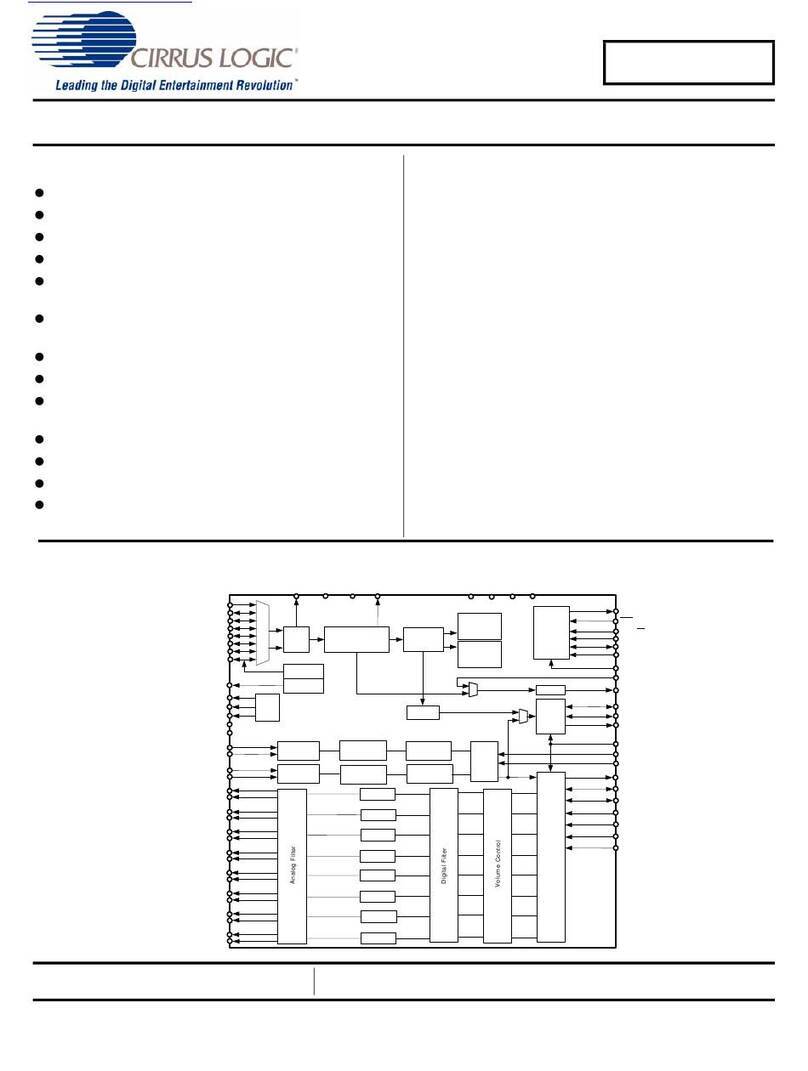
Cirrus Logic
Cirrus Logic CDB42528 User manual
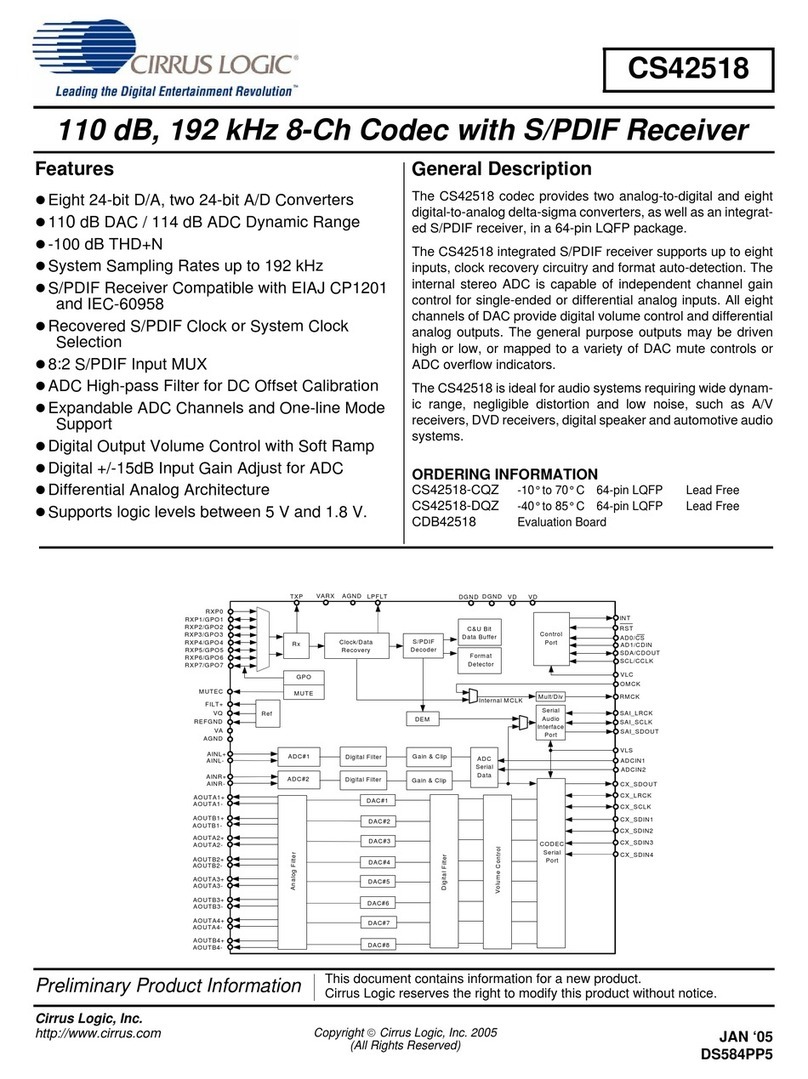
Cirrus Logic
Cirrus Logic CS42518 User manual
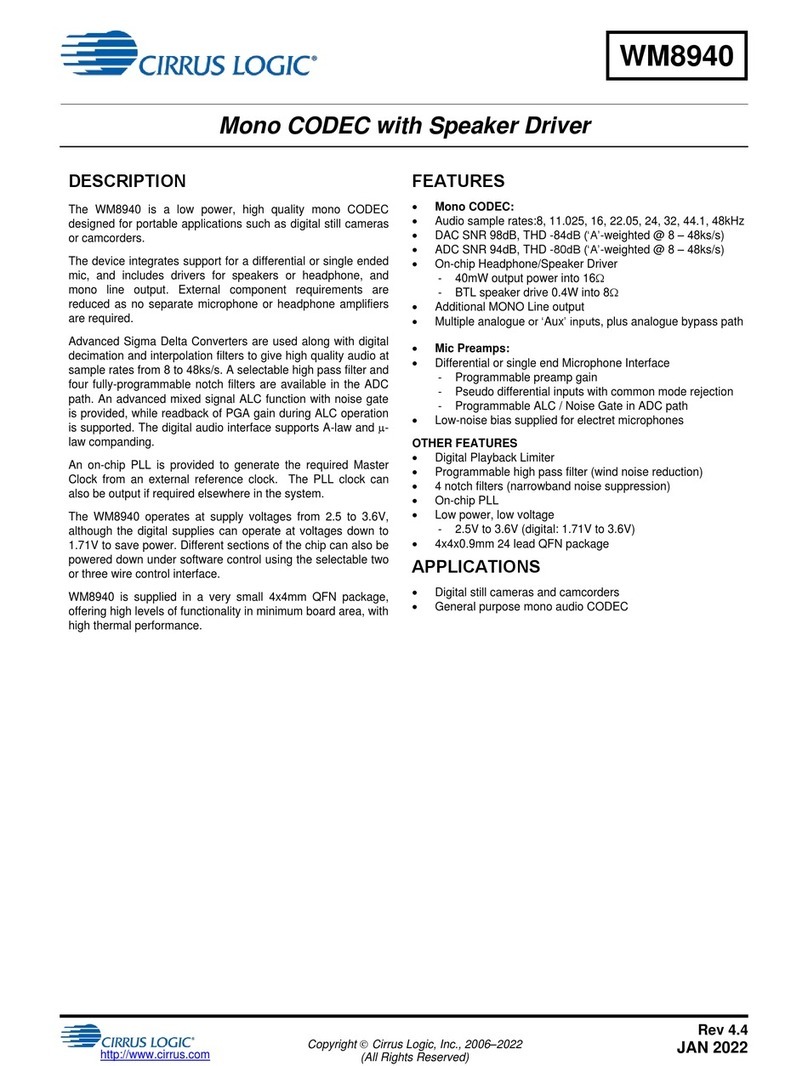
Cirrus Logic
Cirrus Logic WM8940 User manual
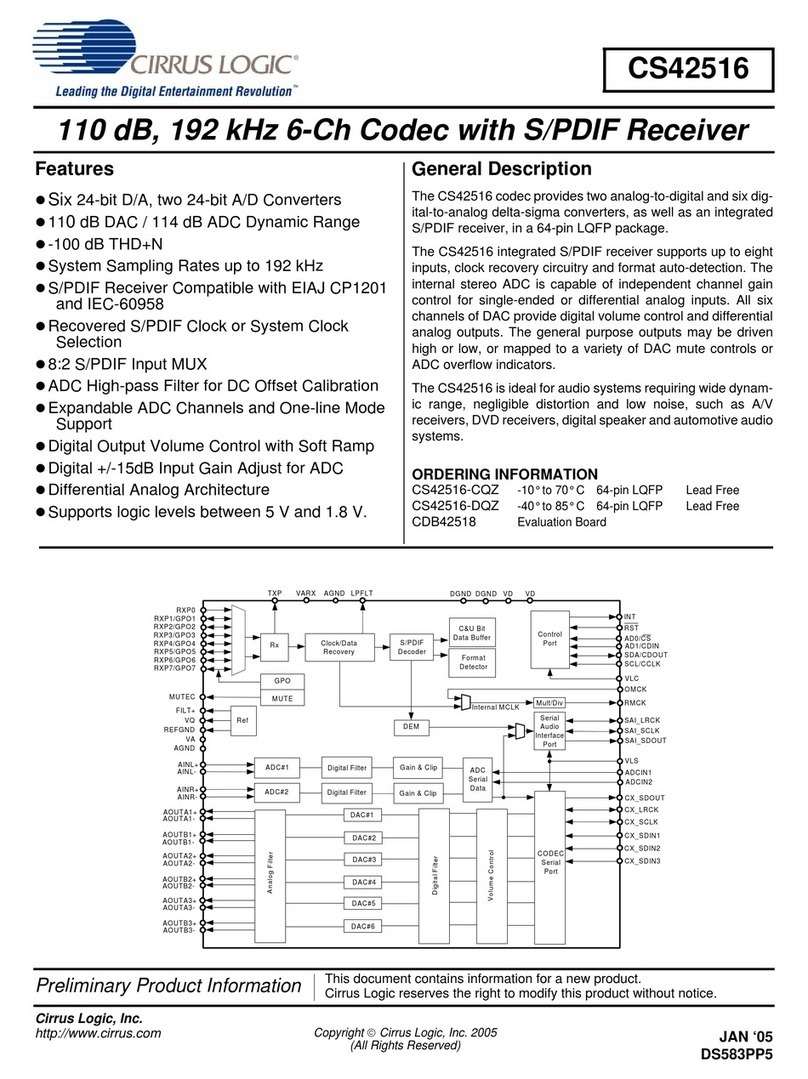
Cirrus Logic
Cirrus Logic CS42516 User manual
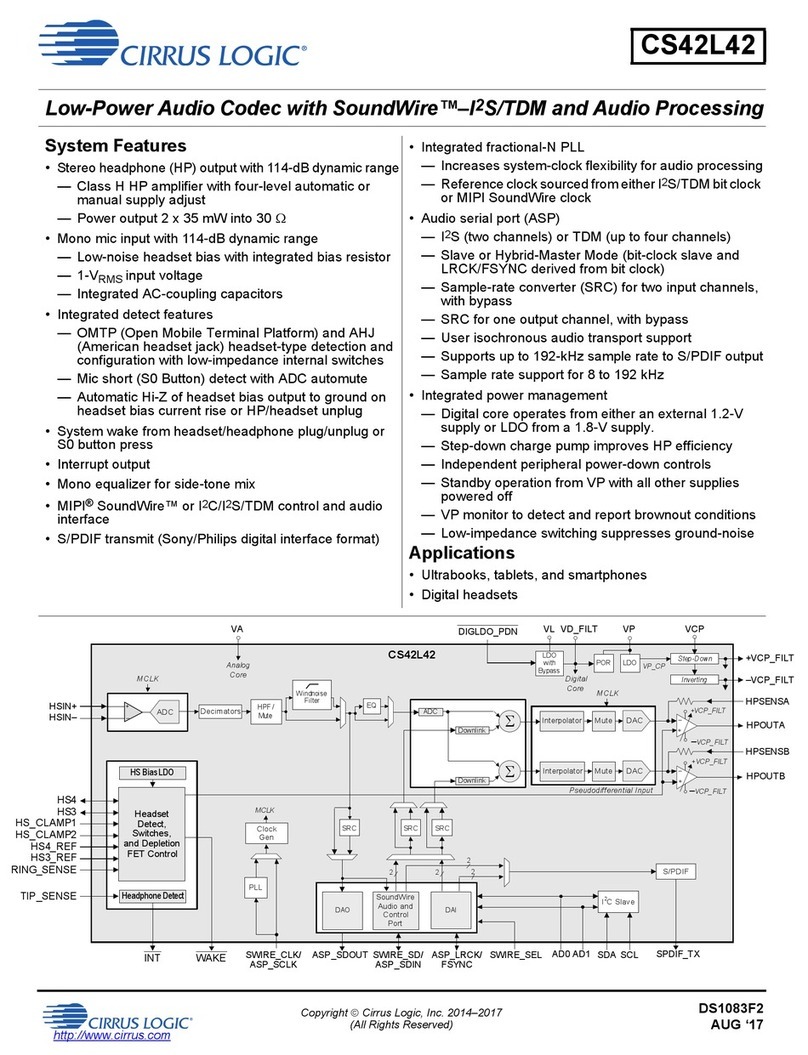
Cirrus Logic
Cirrus Logic CS42L42 User manual
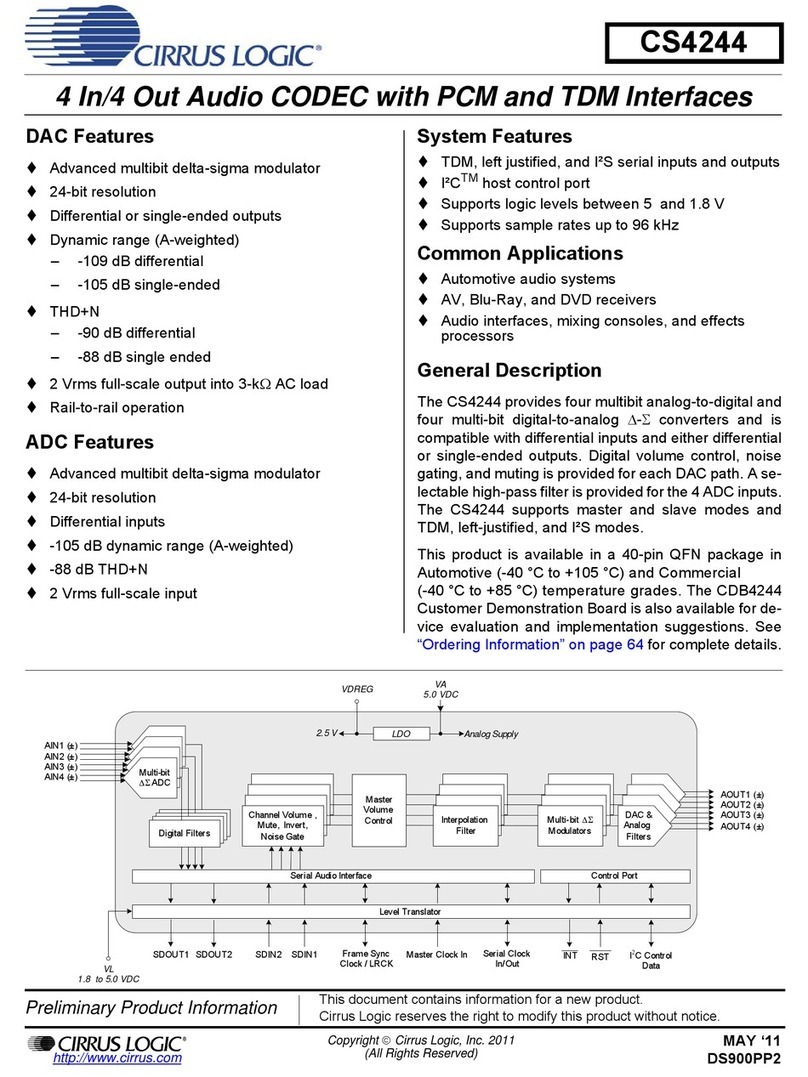
Cirrus Logic
Cirrus Logic CDB4244 User manual
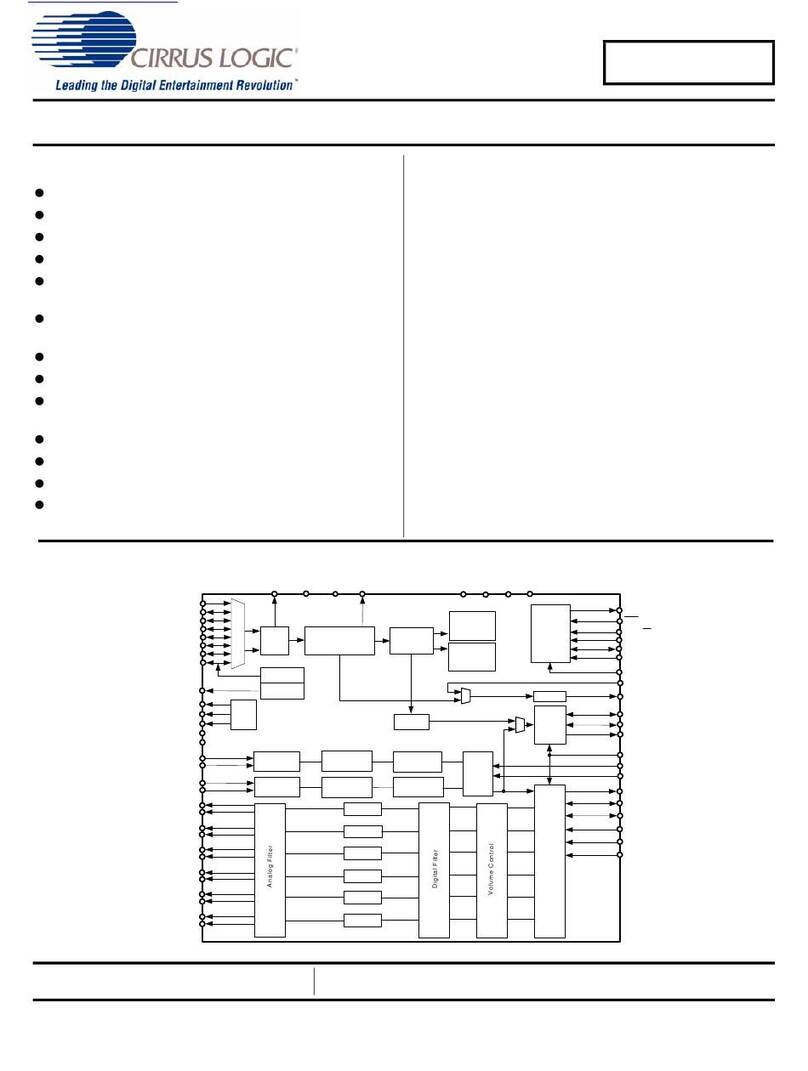
Cirrus Logic
Cirrus Logic CS42526 User manual
Popular Conference System manuals by other brands

Grandstream Networks
Grandstream Networks GXV34 0 Series user guide
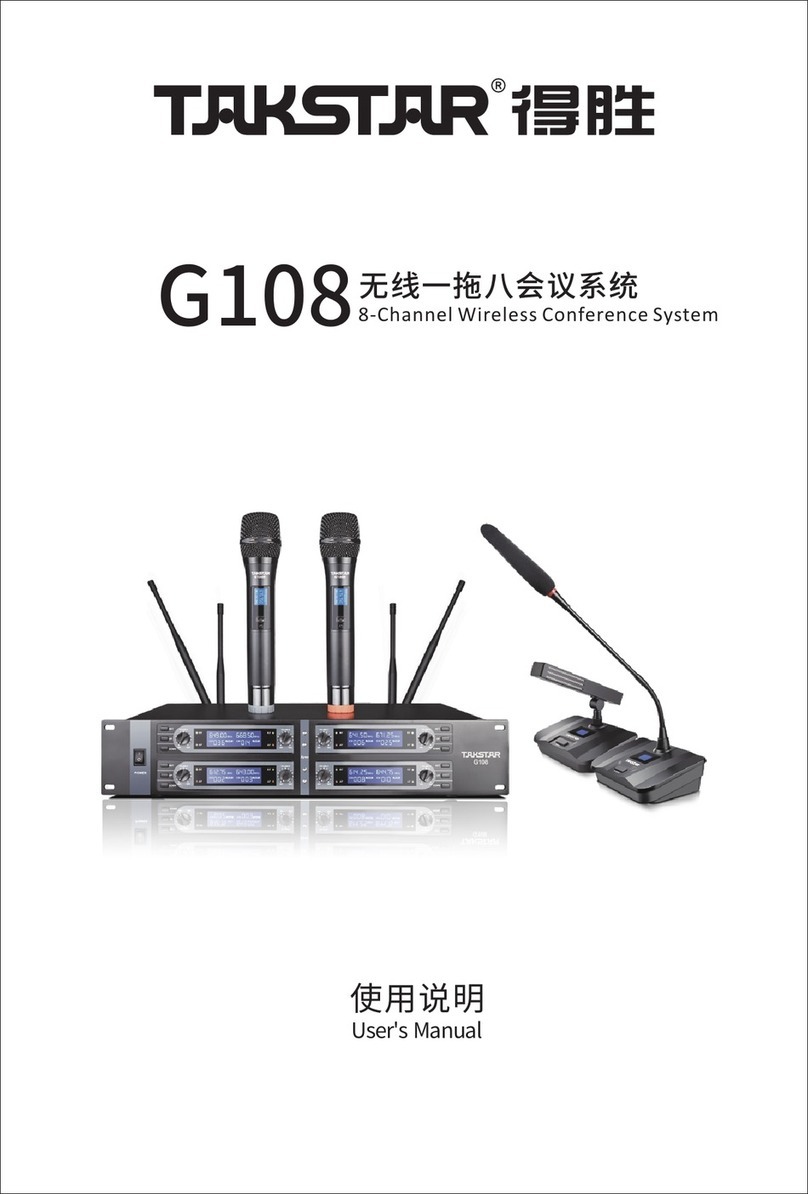
Takstar
Takstar G108 user manual

Polycom
Polycom VSX 7000e Series Software Release Notes
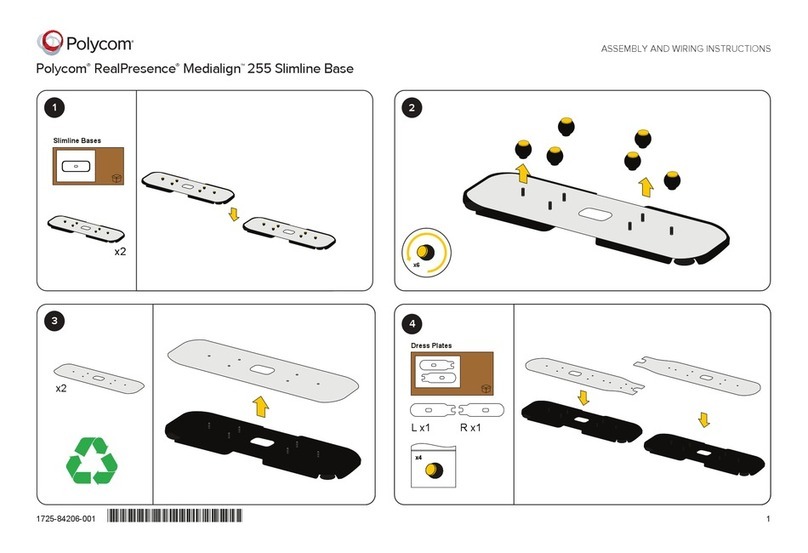
Polycom
Polycom RealPresence Medialign 255 Assembly guide

Cooper Lighting
Cooper Lighting RFM189 instruction manual
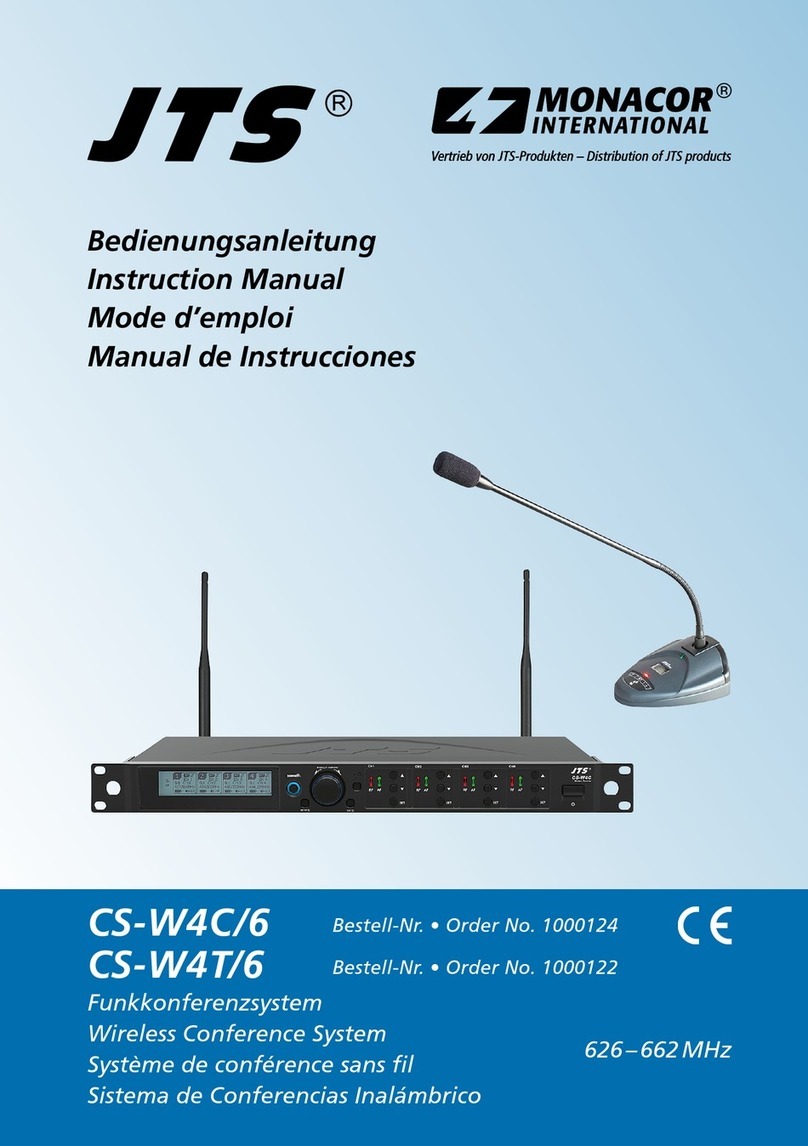
Monacor
Monacor JTS CS-W4C/6 instruction manual


